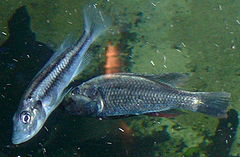Haplochromis
| Haplochromis | |
|---|---|
 |
|
| Haplochromis thereuterion | |
| Scientific classification | |
| Kingdom: | Animalia |
| Phylum: | Chordata |
| Subphylum: | Vertebrata |
| Superclass: | Osteichthyes |
| Class: | Actinopterygii |
| Subclass: | Neopterygii |
| Infraclass: | Teleostei |
| Superorder: | Acanthopterygii |
| Order: | Perciformes |
| Family: | Cichlidae |
| Subfamily: | Pseudocrenilabrinae |
| Tribe: | Haplochromini |
| Genus: |
Haplochromis Hilgendorf, 1888 |
| Type species | |
|
Chromis obliquidens Hilgendorf, 1888 |
|
| Synonyms | |
|
Many, see text |
|
Many, see text
Haplochromis is a ray-finned fish genus in the family Cichlidae. It has been used as the default "wastebin taxon" for Pseudocrenilabrinae cichlids of the East African Rift, and as such became the "largest" fish "genus". Many of these cichlids are popular aquarium fishes; like similar Haplochromini they are known as "haplos", "happies" or "haps" among aquarium enthusiasts.
The genus was established by F.M. Hilgendorf in 1888. It was originally conceived as a subgenus of A.C.L.G. Günther's "Chromis", at that time an even larger "wastebin genus" for Pseudocrenilabrinae cichlids. The type species of Hilgendorf was H. obliquidens. "Chromis" of Günther turned out to be a junior homonym of G. Cuvier's ocean fish genus Chromis, established in 1814 already, and was abolished. As the years went by, other genera of (mostly) Haplochromini were lumped with and split again from Haplochromis, and the final delimitation of the clade around H. obliquidens is not yet done.
The introduction of Nile perch (Lates niloticus) to Lake Victoria after 1954 severely upset the lake's ecosystem. By the late 1970s, the perch's population was approaching carrying capacity, and the smaller cichlids were fair game for the huge carnivorous Lates, the Nile tilapia (Oreochromis niloticus), an adaptable generalist, was also introduced and competed with the often specialized endemic cichlids of the lake for food and other resources. When the Nile perch stocks finally declined again in the late 1980s, an estimated 200 Haplochromini species (mostly Haplochromis) may have become extinct – many of these had only been scientifically described a few years before their demise, and additional ones were only known or suspected to exist, but never properly studied or described.
...
Wikipedia
